440 Search Results for VISUAL SUPPORTS
March 24, 2013
by Carole Zangari -
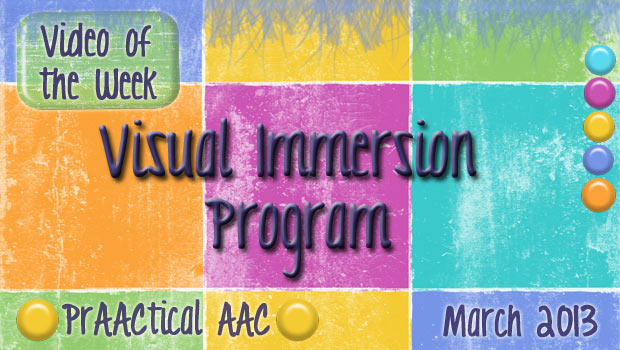
In this week’s featured video, we go to the AAC-RERC to get an in-depth look at a systematic approach to visual supports for people with ASD. Howard Shane and Meghan O’Brien explain the basic premise of the Visual Immersion Program’s approach, the communicative functions it is designed to support, and the key principles and procedures. The webcast is broken into three parts, with accompanying slides and transcripts.
January 28, 2013
by Robin Parker -
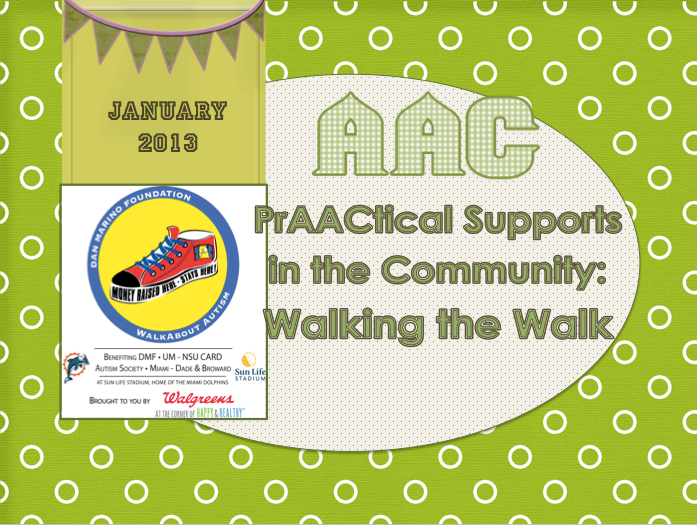
We are extremely proud to be part of the Dan Marino Foundation WalkAbout Autism, which is a large South Florida event. It is a true collaboration between the community, volunteers, sponsors, donors, walk partners, and the Miami Dolphins. The Walkabout helps raise money for organizations that provide programs and services for individuals with autism and other developmental disabilities. It also promotes a sense of community collaboration and awareness about autism spectrum disorder and developmental disabilities. We are writing about the WalkAbout, not as a plea for money (although read about the WalkAbout and donate if you are so inclined), but instead to tell you how we continue to try to integrate AAC & visual strategies into community events. We are so grateful to Dan & Claire Marino and their family and Jeff & Rachel Ireland and their family for continuing to dedicate their time and effort for this amazing event. This past weekend was the 3rd WalkAbout Autism. It was a... [Read More...]
January 3, 2013
by Robin Parker -
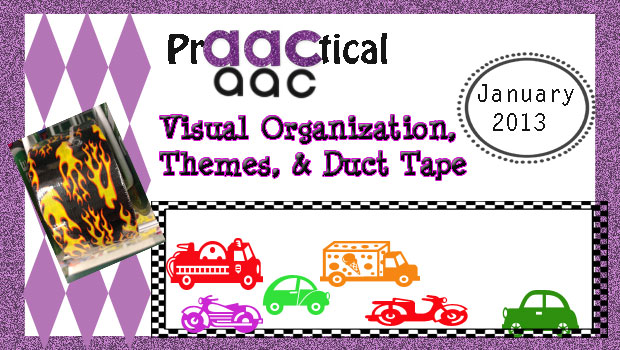
Duct tape just keeps getting better. For full transparency and disclosure, we get nothing and receive nothing from the makers or licenses of any brand of duct tape. We only buy it (although sometimes it might be on sale). We have written about duct tape as a prAACtical behavior strategy, but since that time, the popularity of duct tape as a crafting tool has increased. We are excited not because of the crafting opportunities but instead because we see many more patterns of duct tape in the stores. Any plain duct tape will work as a visual organization tool, but we love that we can add a thematic component to our organization system. Keep in mind, the main point of using duct tape is as a visual organization support. It helps ‘set the stage’ for goal focused interaction and meaningful language experiences. It visually shows expectations. We want learners to... [Read More...]
October 3, 2012
by Robin Parker -
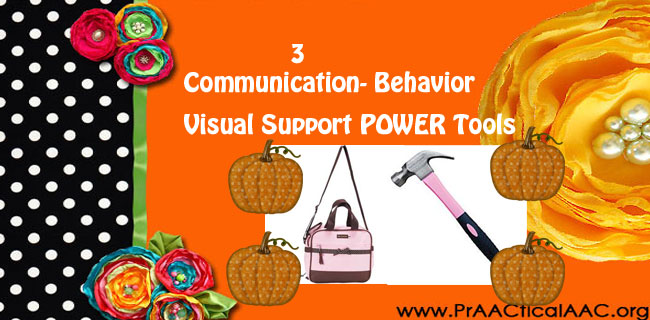
Behavior challenges tend to be a major concern of speech-language pathologists, parents, and educators alike. It is the area that is often most nerve wracking for many professionals and families. But once you get a set of strategies that help you have a plan, most challenging behaviors can be reduced. We like to think of challenging behaviors as opportunities 1: for the learner to practice understanding or expression of communication and language and 2: for facilitators/educators to use behavior strategies or learn new ones. So in order to be best prepared for challenging behaviors, start a Communication-Behavior Strategy Tool Kit. Here some powerful tools that will help ALL learners. 3 Power Tools for Communication & Behavior Choice Boards- helps give a learner power but under our guidelines and boundaries. With choice boards, a student learns more communication while having less power struggles/behavior challenges. Opportunity to teach choice making, expression... [Read More...]
July 20, 2012
by Robin Parker -
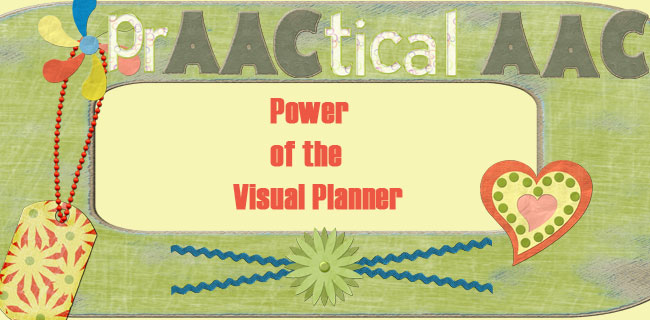
We need to continue to talk about scheduling…..especially as we talk about tools for positive behavioral supports. We know that having monthly, daily, and mini-schedules make us ALL feel more competent and calm. We have written a lot about visual schedules and visual schedule resources because we have seen schedules reduce or eliminate so many behavior challenges. They have helped with transitions, wandering away during activities, activity completion, asking repetitive ‘‘when are we going ________ questions, and with meltdowns during a less preferred activity. We also continue to write about schedules because there are still myths suggesting schedules might hinder independence when exactly the opposite is true. We personally continue to use a combination of no-tech to high-tech visual schedules, but we are loving mobile schedules especially during the summer when we are traveling and moving around from place to place even more frequently than usual. We gathered together... [Read More...]
July 14, 2012
by Robin Parker -
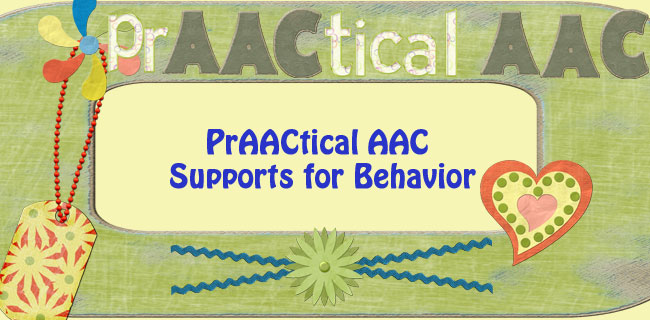
Our July Strategy of the Month, PrAActical AAC Supports for Behavior, is a favorite topic for us, because with a little planning, we can adhere to the old adage that an ‘ounce of prevention is worth a pound of cure’ (as Carole said last week). We also find that behavior challenges are often one of the main reasons, our students (and colleagues) get stressed about working with children with significant communication impairments. And since stress for ANYONE does not make for an optimal learning environment, we love to show how effective preventative strategies work. This week we are focusing on ‘setting the stage’ for conventional and appropriate behavior by engineering the physical environment. We are talking about more than keeping the room neat, clean, and generally organized. We are talking about arranging the physical environment in a planned and careful way in order can make a huge difference in helping... [Read More...]
July 9, 2012
by Carole Zangari -
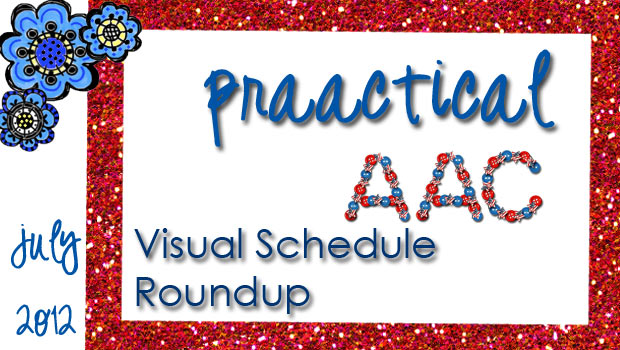
Summer is not the season we typically connect with routine, predictability, and structure. Nonetheless, if strategy really works to make someone’s life better, we try to use it whenever possible. Visual schedules work. They REALLY work. So whether you’re using them this summer or just preparing for the fall, we hope you enjoy this round-up of our past posts on Visual Schedules. – Riddle Me This (clinical rationale) Tech it Up’- 5 Visual Schedule Apps (tools) Visual Strategies 411 (implementation) PrAACtical Mini Schedules (implementation) Ideas for Teaching the Use of Visual Schedules (implementation) Object Schedules (video) Strategy of the Month: Types of Visual Schedules (implementation) Visual Schedules in Action (video) Building Complex Schedules (video) Schedule Changes (Video) AAC at Home: Visual Schedules and Supports Schedules and Choices (implementation) Visual Schedules & Inclusion (video) A Myth About Visual Schedule Lives On (implementation) Visual Schedule Wrap-Up (implementation + resource list) –
July 7, 2012
by Carole Zangari -
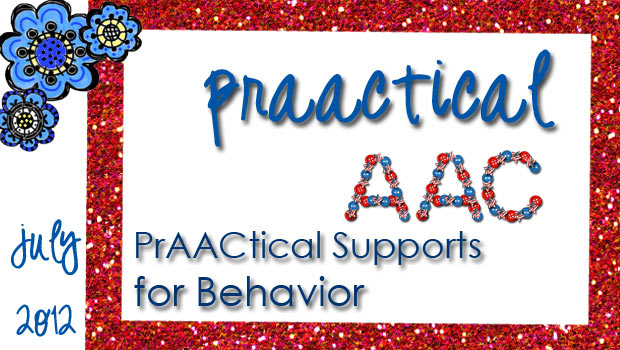
Rachel arrives to therapy tense and upset. Mauro gets frustrated when the clinician presents new activities. Brianna starts to bang the table when demands are placed on her. Zach becomes agitated when he has to wait for something he wants. – Like any set of tools and strategies, AAC works best when the communicator is relaxed, confident, and engaged. Our July Strategy of the Month focuses on PrAACtical Supports for Behavior. We hope to share ideas for planning therapy sessions that help AAC learners stay focused, calm, and engaged. — We’re big believers in the old adage that an ounce of prevention is worth a pound of cure. So, what can we do to prevent or minimize problems like the ones experienced by Rachel, Mauro, Brianna, and Zach? The answers have to do with having clear and appropriate expectations, and using visual and AAC supports effectively. When used consistently, these strategies... [Read More...]
June 20, 2012
by Carole Zangari -
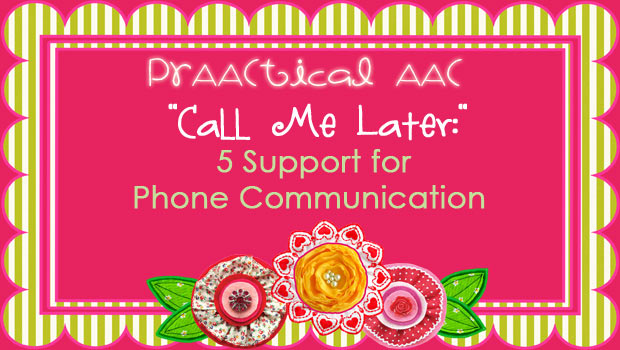
While I am not one of those folks who has a phone glued to her ear, I sure wouldn’t want to live without the ability to make a phone call. Here are some sites with information of interest to people with AAC needs. 1. Photo Phone Dialing: While many high tech SGDs can do phone dialing, sometimes the best solution is the simplest one. For some people, using a phone that has prestored numbers stored under photo buttons, provides just enough support to make the call. Once the call is placed, however, out comes the SGD so the conversation can proceed. – 2. Phone Skills: We’re not born knowing how to use the phone and some of our AAC friends have needed direct instruction and lots of practice phone skills. Making visual supports, like this one from SET BC, can help. Another neat tool is the Tele-Trainer, which is a... [Read More...]
June 8, 2012
by Robin Parker -
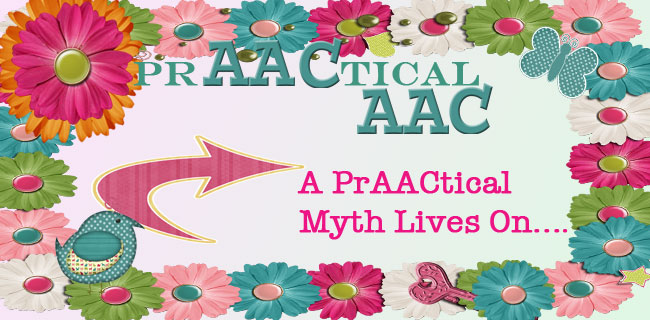
A myth about visual schedules continues to rear its ugly head in a prAACtical situation. Another family was instructed to discontinue a visual schedule because “the schedule will become a crutch, the schedule will result in dependence, and the schedule can not be used forever or all over town”. I need to start with an apology for not following up after my earlier post when I first realized that the visual schedule myth lived on. Maybe my punishment was hearing the same myth repeated (though it doesn’t seem fair that a student was impacted in the process). But maybe it was a teaching opportunity for me. It certainly made me respond quickly. So now for the down and dirty summary of my conversation with the other ‘professional’ . Having the conversation was my attempt at helping my student receive the visual language supports that she needed. I have to admit, it... [Read More...]









